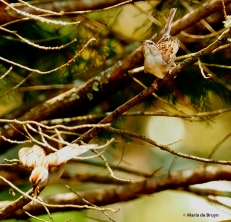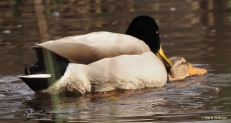If you’ve had the good fortune to watch a bird caring for nestlings and then encouraging them to enter the big wide world, you might think that the young ones automatically know how to fly. But my recent observations of a ruby-throated hummingbird family (Archilochus colubris) showed me that a learning curve — albeit not a long one — may be involved.
 On the 29th of April, my friend Ace and I had the good fortune to spot a female hummingbird. We discovered that she was gathering construction materials for a nest with inside walls that included plant down.
On the 29th of April, my friend Ace and I had the good fortune to spot a female hummingbird. We discovered that she was gathering construction materials for a nest with inside walls that included plant down.
She was camouflaging the outside of the walls with lichen.
As she worked on the nest, she sat in it periodically, moving her body to form the cup shape and tamp down the bottom.
The walls expand as the eggs hatch and nestlings grow; this is possible because the walls are held together by spider web and caterpillar webbing (6 May).
 If we hadn’t seen her working on the nest, we likely would not have seen it. It was very cleverly placed near the crook of a small branch that had lichen growing nearby (13 May).
If we hadn’t seen her working on the nest, we likely would not have seen it. It was very cleverly placed near the crook of a small branch that had lichen growing nearby (13 May).
 I noticed a twig curving down from the branch beneath the nest and that became the marker for finding it again — not always an easy task as the hummer home blended in so very well with the tree she had chosen.
I noticed a twig curving down from the branch beneath the nest and that became the marker for finding it again — not always an easy task as the hummer home blended in so very well with the tree she had chosen.
 Just after mid-May, I had to stop my observations as I had the immensely good fortune to visit Yellowstone National Park (blogs on that coming up!). It was only on 4 June that I was able to visit the hummer nest again and it was a thrill to see two babies had emerged from the coffee bean-sized eggs.
Just after mid-May, I had to stop my observations as I had the immensely good fortune to visit Yellowstone National Park (blogs on that coming up!). It was only on 4 June that I was able to visit the hummer nest again and it was a thrill to see two babies had emerged from the coffee bean-sized eggs.
 During their first days, young hummingbirds are very vulnerable. They are blind for about 9 days and only begin to grow pin-like feathers after about 10 days!
During their first days, young hummingbirds are very vulnerable. They are blind for about 9 days and only begin to grow pin-like feathers after about 10 days!
 Mom would come by and regurgitate food (insects and nectar) into their open mouths.
Mom would come by and regurgitate food (insects and nectar) into their open mouths.
When the chicks grew enough to peer over the nest’s edge, we were able to watch them surveying their surroundings.

The two of them would look around in unison.
They moved around the nest more and more, jostling for space. By 3 weeks of age, ruby-throated hummingbirds are fully feathered and getting ready to fledge.
On 7 June, I had a premonition that fledging was going to occur that day. I had volunteer duty in the morning (to pull invasive plants at a local reserve) so I could only visit the nest briefly before going to work.
The babies were both flexing their wings a lot. Hummers typically flap their wings 50-200 times per second! It turned out that they needed to exercise a lot, or they weren’t going to be able to get the lift needed to leave the nest.
 The nestlings flapped back and forth as they revved up their muscles for a coming take-off. Their pectoral muscles need to be strong for their airborne flights and may account for up to 30% of their body weight.
The nestlings flapped back and forth as they revved up their muscles for a coming take-off. Their pectoral muscles need to be strong for their airborne flights and may account for up to 30% of their body weight.
Watching with excitement as I maneuvered a bit to get better lighting for photos, I saw one of the little ones begin to lift (above). S/he flapped furiously. I got a photo of the lift off but not the actual departure from the nest.
One nestling remained and s/he began flapping vigorously.
 I had to stop my vigil as it was time to get to the nature reserve. While leaving, I ran into Ace and told him that one hummer had just fledged, and the other was getting ready so that he could see the event!
I had to stop my vigil as it was time to get to the nature reserve. While leaving, I ran into Ace and told him that one hummer had just fledged, and the other was getting ready so that he could see the event!
After my 2-hour shift, I drove back to the nest. Ace had let me know that Chick No. 2 had not yet left while he was watching. Sure enough, when I returned the little one was still there (above).
He moved around a lot but didn’t seem to be going anywhere.
It seemed that Chick No. 2 was not getting the lift needed to soar up and away despite all its efforts.
 Mom came to give some encouragement.
Mom came to give some encouragement.
She also gave Chick No. 2 a bit of nourishment.
 That seemed to provide the young one with renewed energy as the practice wing flapping resumed vigorously.
That seemed to provide the young one with renewed energy as the practice wing flapping resumed vigorously.
After a couple hours, I needed to leave to do other things. I took a few more photos of the hard-working almost-fledgling.
The next morning, I visited the hummer home again wondering whether anyone would still be in residence. The nest was empty so Chick No. 2 had departed the previous afternoon or evening. But as I watched, a hummer was zipping around the tree and the nest.
I think it was Mom. She may have been considering whether the nest could serve as a spot to raise another brood. It might also have been one of the young ones returning for a last look at home.
 Observing the hummingbird nest over a period of weeks was a wonderful learning experience. I’ll treasure the memory for a long time to come. And I now have an even greater appreciation for these tiny birds that become flying gems in our natural surroundings.
Observing the hummingbird nest over a period of weeks was a wonderful learning experience. I’ll treasure the memory for a long time to come. And I now have an even greater appreciation for these tiny birds that become flying gems in our natural surroundings.
































 11
11

























































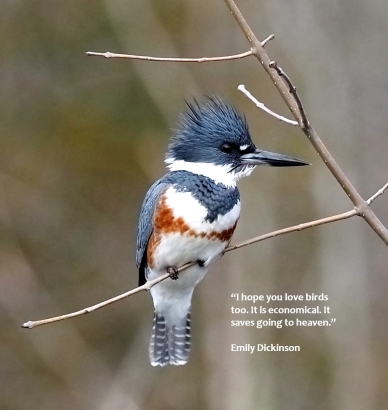









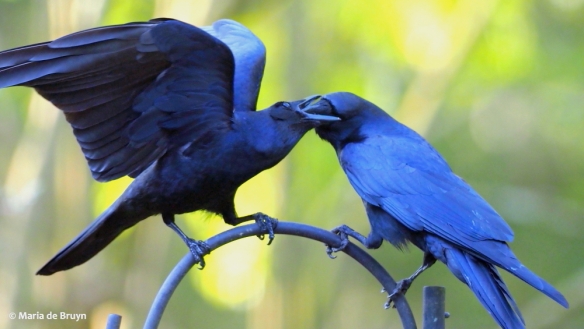







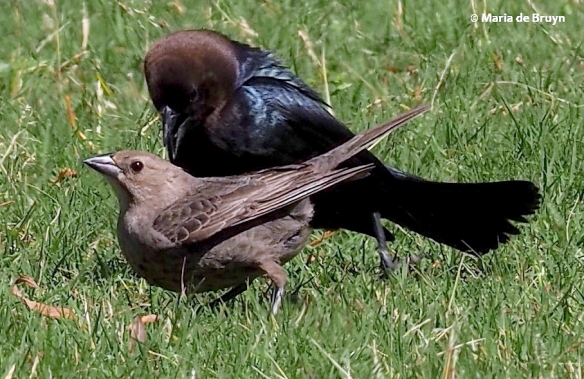
 The quickest mating scenario I’ve witnessed came from a pair of sweet little chipping sparrows (Spizella passerina). I’d seen the two fluttering together at the feeders and had noted one sparrow chasing another away – which I now think was the victorious suitor driving away a rival. Then one July afternoon, the two flew to a dying cedar and sat close to one another on a branch. Suddenly, Mr. Victory mounted his mate but for what only seemed a few seconds – really very quick work indeed! She sat there with her rear end elevated for a bit and then the two went back to feeding – and soon after I saw them collecting nesting materials.
The quickest mating scenario I’ve witnessed came from a pair of sweet little chipping sparrows (Spizella passerina). I’d seen the two fluttering together at the feeders and had noted one sparrow chasing another away – which I now think was the victorious suitor driving away a rival. Then one July afternoon, the two flew to a dying cedar and sat close to one another on a branch. Suddenly, Mr. Victory mounted his mate but for what only seemed a few seconds – really very quick work indeed! She sat there with her rear end elevated for a bit and then the two went back to feeding – and soon after I saw them collecting nesting materials.
